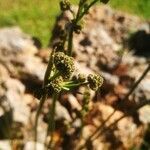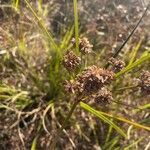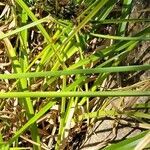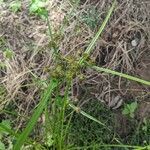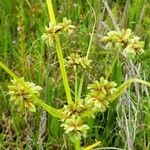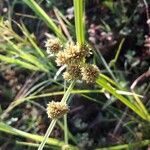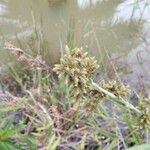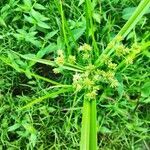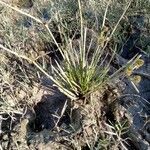Herbs, annual, cespitose. Culms 1–15, trigonous, 7–30 cm × 1.2–2.5 mm, soft (flattened in pressing), glabrous. Leaves 2–7, flat, (2–)7–22 cm × 2.2–4 mm. Inflorescences: heads dense, 7–17 mm diam.; when rays short, heads sessile or nearly so, then densely irregularly lobate, 12–35 mm diam.; rays 1–5, 2–32 mm; bracts 2–4, longest bract erect or nearly so, appearing as continuation of culm, other bracts horizontal to ascending, 1–22 cm × 0.5–3.5 mm, margins and keel minutely scabridulous. Spikelets 30–120, greenish brown to purplish brown, oblong-ellipsoid, compressed, (2–)3–5(–6) × 0.8–1.2 mm; floral scales (6–)12–20(–30), laterally clear margins, stramineous to deep purple, medially greenish, stramineous, or purplish, laterally ribless, medially 3-ribbed, obovate to orbiculate, 0.6–0.8 × 0.6–0.8 mm, apex mucronulate. Flowers: stamens 1 or 2; anthers ovoid-ellipsoid, 0.1 mm, connective not prolonged; styles 0.1 mm; stigmas 0.1–0.3 mm. Achenes light brown, obovoid-ellipsoid, 0.6–0.8 × 0.3–0.4 mm (as long as subtending scale), base cuneate, apex obtuse, apiculate, surfaces finely reticulate, papillose.
Annuals. Roots fibrous. Culms tufted, 2-65 cm tall, slightly thick or flaccid, compressed triquetrous, smooth, few leaved at basal part. Leaves shorter than culm; sheath brown, slightly long; leaf blade 2-6 mm wide, flat or folded. Involucral bracts 2(or 3), leaflike, longer than inflorescence. Inflorescence a simple or rarely compound anthela; rays 3-9, mostly to 3(-5) cm, unequal in length, each with many spikelets at apex densely aggregated into a capitulum. Capitulum of spikelets globose, 0.5-1.5 cm in diam. Spikelets narrowly ovoid to linear, 2-8 × 1-1.2 mm, compressed orbicular, 8-28-flowered; rachilla wingless. Glumes dark reddish purple to dark grayish brown on both surfaces but middle yellowish, less than 1 mm, slightly spreading, obscurely 3-veined, margin white hyaline, apex rounded. Stamens (1 or)2; anthers ellipsoid; connective not prominent beyond anthers. Style very short; stigmas 3, short. Nutlet yellowish, obovoid-ellipsoid, nearly as long as subtending glume, 3-sided. Fl. and fr. Jul-Oct. 2n = 18, 28, 32, 34, 36.
Annual herb, tufted, 0.05-0.80 m high. Leaf blades up to 3.5 mm wide, flat, flaccid. Culm scapose, ± 3-angled, often with a lax spiral twist, 2.5-3.5 mm in diam. Inflorescence variable, ranging from a simple, digitate, head-like cluster of spikelets to a compound anthela. Subtending bracts 3 or 4, leaf-like. Spikelets linear, 5 x 0.8 mm, 10-30-flowered. Glumes minute, boat-shaped, 0.6-0.8 mm long, keel not excurrent or excurrent into minute point. Flowering time Dec.-June. Nutlet obovate-elliptic, 0.6-0.8 x 0.3-0.4 mm, 3-angled, yellowish brown, surface finely reticulate or puncticulate.
Tufted annual 2–6 dm, bearing 2–4 bracts and several sessile or short-peduncled, globose, densely fld heads 8–12 mm thick; spikelets 4–8 mm, scarcely flattened, 10–40 fld; rachilla not winged; scales obovate-rotund, often broader than long, 0.5–0.8 mm, with reddish or brownish sides; stamen 1(–3); achenes light yellowish, trigonous, about equaling the scales. Wet soil; native of the Old World tropics, intr. in se. Va.
Annual herb, up to 0.8 m high; slender. Leaf blades developed. Flowers: inflorescence a solitary, congested anthela or with many, subumbellately arranged heads; spikelets digitate; glumes and nutlets abscising individually leaving a persistent rachilla; glumes many per spikelet, 0.5-0.7 mm long, with a winged keel, dark reddish brown; Feb.-May.
A slender to medium-sized, annual herb, up to 0.8 m high. Inflorescence a solitary, congested anthela or with many, subumbellately arranged heads. Glumes 0,5-0,7 mm long with a winged keel, dark reddish brown.
A sedge. It grows 50 cm tall.
